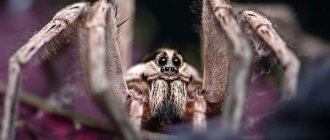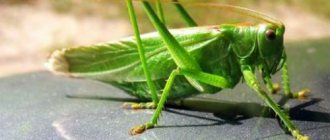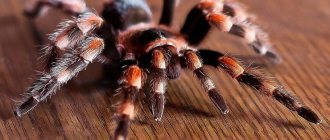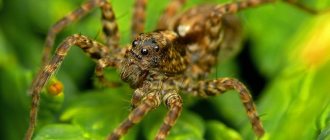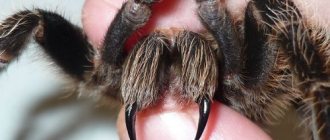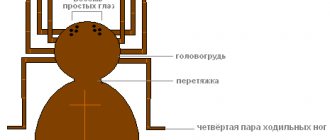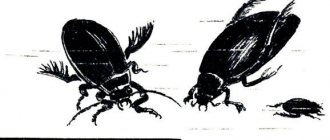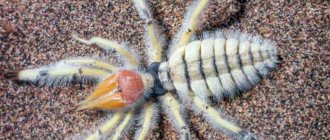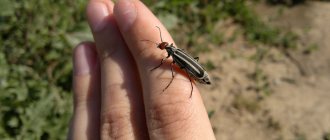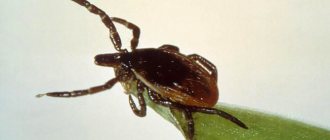Name
In Russian and Ukrainian it is called the South Russian tarantula (due to the distribution of the species in the south of Russia). Popularly called “mizgir”.
In other languages, it is often named after the territories where it is found: Romanian (Romanian românească), Tatar (Czech tatarský), Ukrainian (Polish ukraińska), Dzungarian and the like.
Female
Description of appearance
The South Russian tarantula spider is one of the largest representatives of the spider family in Russia.
- The female reaches a size of 32 mm, males grow up to 27 mm.
- The body is divided into 2 parts - a convex abdomen and cephalothorax. The parts are connected to each other by a thin jumper.
- 4 pairs of long limbs not only help the tarantula move, but are also organs of smell and touch. On the lower part of the legs there are hairs with which the wolf spider receives signals from the external environment.
There are 8 eyes on the head of the South Russian tarantula, located in different parts - 4 look forward, 2 on the sides, and another pair looking back. The visual field of view is 360 degrees. However, the South Russian tarantula sees poorly and receives visual images in the form of shadows and silhouettes. Reacts well to movement.
On a note!
The color of the mizgir can be different, depending on the habitat - brown, gray, black. The upper part of the abdomen and cephalothorax are always darker, with a pattern of light spots. A photo of the Mizgir spider is located below.
South Russian tarantula (mizgir spider)
Description
One of the largest spiders in Europe, the largest in Central Europe and Ukraine. Body size up to 4 cm, with legs up to 7 cm. Body weight from 2.6 to 7 grams. The upper side of the body is variegated, the sides are light, the upper side of the abdomen is black. The body is covered with gray and white hairs of different lengths, so it looks shaggy. On the cephalothorax there is a pattern of dark stripes extending radially from the center. The main segment of the chelicerum is bright yellow or orange, the tip and claw are black. The pedipalps are also yellow except for the black tip. Legs underneath with black rings.
Thanks to its protective coloring, the South Russian tarantula is perfectly camouflaged on the soil surface
Sexual dimorphism
Females have a larger abdomen and short legs compared to males and are stockier. The hairs of males are lighter. The size of males is 14–27 mm, females - from 18 to 31 mm, according to some sources - up to 35 mm.
Male
Races
There are three “races” of South Russian tarantulas: large, small and intermediate. The large one is found only in the south of Central Asia, the intermediate one is found most northern. Small common in the south of the steppes. All races interbreed freely with each other.
Reproduction
The process begins at the end of summer. The male carefully courts the female, attracting her attention. After mating, his task is to quickly get out of sight, since a hungry aggressive female can eat him.
Spider Reproduction
After hibernation, the spider weaves a cocoon from the web and lays several hundred eggs there. It carries with it the entire period of development of the larvae, as well as for some time after their birth.
Interesting!
The abdomen of the misgir is dotted with small spiders, the number of which reaches up to 50 pieces. The mother feeds the young offspring and, as they grow older, throws them away from the mink.
Lifestyle
The lifestyle is similar to that of the closely related Apulian tarantula (Lycosa tarantula).
Female in the ornithological reserve Bulakhovsky Estuary, Ukraine, Dnepropetrovsk region
Nutrition
The female South Russian tarantula digs a more or less vertical hole up to 50–60 cm deep, the inner wall of which is covered with cobwebs. The entrance to the hole is about the diameter of a mouse hole, the web protrudes from the surface of the soil and is reinforced by twisted stems of grass and other plants. It does not build a trapping net, but reacts to the movement of prey, which approaches the edge of the burrow and pulls the signal spider threads: it jumps out of the burrow and bites. At night it moves a short distance from the shelter. It most often hunts beetles and orthoptera, but any insects and smaller spiders can become prey.
At the entrance to the hole
Reproduction
Tarantulas mate in late summer. The male approaches the female's burrow and taps the web with his front legs. The female comes out, and then he begins to stroke her limbs with a slight vibration of his legs. Sometimes the female will still attack the male. When the male manages to calm her down, he enters the hole, where mating takes place.
Entrance to the hole
In the spring, the female lays 200–700 eggs in a cocoon, which she warms in the sun, crawling out to the edge of the burrow and sitting there upside down, with her abdomen with the attached cocoon out. After the small spiderlings hatch (usually in May), she collects them on the upper part of her abdomen and travels, from time to time dropping some of the offspring, thus distributing them. At the same time, the female can swim across small water obstacles.
The female before laying eggs. After laying eggs, the size of the abdomen decreases sharply
Female with cubs, Chelyabinsk region
Tarantulas grow during molting, molting 11 times.
Female with young
Reproduction and offspring
At the end of summer, the Mizgiri mate; the males lure the female with special movements. The answer is the same movements of the partner if she is ready for mating games. They often end tragically; excited females simply kill the Mizgiri if they do not have time to escape.
The female makes a cocoon from the web, into which, with the onset of spring warmth, she lays fertilized and mature eggs. In the warmth of human habitation, the female tarantula may not hibernate. She is able to lay eggs almost immediately, and then carry the cocoon with her attached to her abdomen, waiting until the babies - spiderlings - are formed.
Feeling movement, the female helps the babies get out. But for some time she carries the offspring attached to her abdomen, helping to obtain food. One pair can have up to fifty cubs. As soon as the babies become able to survive on their own, the mother begins to tear them off her abdomen with her paws, scattering them away from her own home. Young tarantulas build their burrows according to their size, gradually enlarging them.
Natural enemies
Tarantulas are preyed upon by parasitoid road wasps (pompylids), which paralyze the spiders and lay eggs on them, from which a larva develops that slowly eats the spider. In particular, these are Anoply Samara (listed in the Red Books of Chuvashia, Ukraine and Moldova) and Cryptochol annularis (listed in the Red Book of Ukraine).
Cryptocheilus alternatus
The eggs are destroyed by various species of ichneumon ichneumon. Young tarantulas are hunted by mole crickets.
In Kazakhstan, tarantulas are eaten by the endemic rodent Selevinia, which, however, is rare.
Spreading
Distributed in deserts, semi-deserts, steppes and forest-steppes from Austria and Hungary to the Caspian Sea, Central Asia, Southern Siberia, the Russian Far East and Northwestern China. Also lives in Turkey, the Middle East, and Egypt. In Ukraine, it is distributed throughout almost the entire territory, except for the main part of the Carpathians (however, it is found in the Volcanic Massif). Occasionally found further north, especially along river banks with sandy soils.
Security
It is included in the Red Books of many constituent entities of Russia, in particular the Moscow, Kaluga, Ryazan, Tula, Sverdlovsk and Nizhny Novgorod regions, and the Perm Territory. In Ukraine, it is included in the list of animals subject to protection in the Kyiv region.
In the landscape reserve of national significance Soleny Liman, Ukraine
South Russian tarantula and man
Unlike the Apulian tarantula, the South Russian tarantula is almost not feared in its range. There are even reports from Ukraine of children playing with tarantulas to pass the time.
Bite incidents and toxicity
The spider's chelicerae are large and strong enough to bite through human skin. However, the effect of the poison itself has practically no significant consequences for humans. Redness and swelling occur in the area of the bite wound. Rarely, the bite can also cause a fever. In any case, bites are rare due to the low aggressiveness of the spider. As a rule, in case of danger, the South Russian tarantula prefers to hide and bites only if there is no other way out - for example, a spider has been driven into a corner. Before biting, it straightens up and raises its front pairs of legs.
In a terrifying pose
South Russian tarantula (mizgir): appearance
South Russian tarantula (mizgir), photo
Mizgir has distinctive external characteristics, thanks to which it is quite easy to distinguish it from other representatives of the genus. The spider stands out among other species of spiders that have the same habitat.
Distinctive features
Females can reach 3 cm in length. Males are slightly smaller - up to 2.5 cm. However, it is generally accepted that there are individuals whose size significantly exceeds the specified standards. Mizgir has 6 pairs of eyes. The body shape of the spider is similar to other tarantulas.
Mizgir is distinguished by its rather bright coloring, which allows it to camouflage itself in tall grass. The main color is sandy, its saturation can vary from almost gray to rich yellow. The chelicerae of arthropods are colored and most often have a reddish tint. The entire body of the South Russian tarantula is covered with stripes of black or dark brown. They are especially clearly visible on the spider's limbs.
Where does the South Russian tarantula (mizgir) live?
This type of tarantula lives in steppes, semi-deserts and deserts. It can also be found in the forest-steppe zone. Mizgir is widespread in the following places:
- Russia;
- Middle Asia;
- Ukraine;
- Belarus.
The habitat of the arachnid is gradually expanding. But it can only be found in areas with a dry climate, since the South Russian tarantula is very sensitive to humidity. Fertilized females often migrate to new places, which contributes to the rapid spread of the species.
